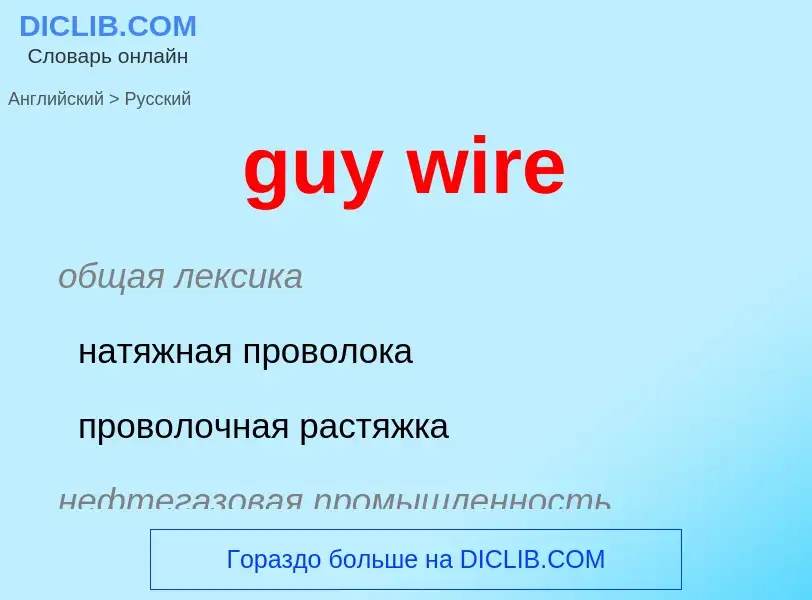Translation and analysis of words by ChatGPT artificial intelligence
On this page you can get a detailed analysis of a word or phrase, produced by the best artificial intelligence technology to date:
- how the word is used
- frequency of use
- it is used more often in oral or written speech
- word translation options
- usage examples (several phrases with translation)
- etymology
guy wire - translation to russian
общая лексика
натяжная проволока
проволочная растяжка
нефтегазовая промышленность
растяжка
ветровая оттяжка (трубопровода)
натяжной трос
общая лексика
оттяжка
строительное дело
оттяжка, расчалка
Wikipedia

A guy-wire, guy-line, guy-rope, down guy, or stay, also called simply a guy, is a tensioned cable designed to add stability to a free-standing structure. They are used commonly for ship masts, radio masts, wind turbines, utility poles, and tents. A thin vertical mast supported by guy wires is called a guyed mast. Structures that support antennas are frequently of a lattice construction and are called "towers". One end of the guy is attached to the structure, and the other is anchored to the ground at some distance from the mast or tower base. The tension in the diagonal guy-wire, combined with the compression and buckling strength of the structure, allows the structure to withstand lateral loads such as wind or the weight of cantilevered structures. They are installed radially, usually at equal angles about the structure, in trios and quads. As the tower leans a bit due to the wind force, the increased guy tension is resolved into a compression force in the tower or mast and a lateral force that resists the wind load. For example, antenna masts are often held up by three guy-wires at 120° angles. Structures with predictable lateral loads, such as electrical utility poles, may require only a single guy-wire to offset the lateral pull of the electrical wires, at a spot where the wires change direction.
Conductive guy cables for radio antenna masts may disturb the radiation pattern of the antenna, so their electrical characteristics must be included in the design.


![Closeup of anchor end of three guy-wires used to support the [[KVLY-TV mast]] in North Dakota, the tallest guyed mast in the world. Each guy is one member of a set of three that is located radially around the tower Closeup of anchor end of three guy-wires used to support the [[KVLY-TV mast]] in North Dakota, the tallest guyed mast in the world. Each guy is one member of a set of three that is located radially around the tower](https://commons.wikimedia.org/wiki/Special:FilePath/KVLY-TV tower, North Dakota 019.jpg?width=200)
![Guy (red arrow), controlling the [[spinnaker]] pole. Guy (red arrow), controlling the [[spinnaker]] pole.](https://commons.wikimedia.org/wiki/Special:FilePath/Segeln Spinnaker-Achterholer.jpg?width=200)

 7 use tag lines to steady a 20,000-pound load during a crane lift to load cargo onto a tractor trailer.jpg?width=200)
